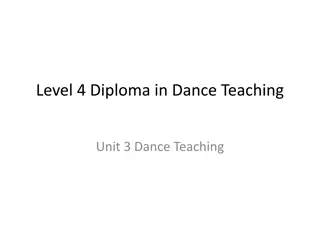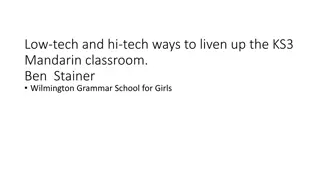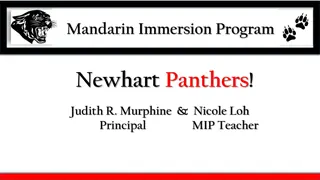Mandarin Unit Plan: About Me - Teaching Resources for NZ Schools
This Mandarin unit plan focuses on the theme "About Me," introducing students to basic Mandarin vocabulary including numbers, colors, and animals. The plan includes classroom instructions, specific learning objectives, songs, activities, and games to engage students in learning Mandarin language and culture. Through interactive lessons and fun activities such as movement circles, puppet swap, and color matching games, students will practice greetings, expressing likes and dislikes, and recognizing colors and numbers in Mandarin. Cultural aspects, cultural color associations, and Chinese number hand signals are also explored in this comprehensive teaching resource designed for New Zealand schools.
Download Presentation

Please find below an Image/Link to download the presentation.
The content on the website is provided AS IS for your information and personal use only. It may not be sold, licensed, or shared on other websites without obtaining consent from the author. Download presentation by click this link. If you encounter any issues during the download, it is possible that the publisher has removed the file from their server.
E N D
Presentation Transcript
Chinese Teaching Resources for NZ Schools Unit Plan About Me -Mandarin Introduction Topic: About Me - My Name is I am years old, expressing like and dislikes Introduction Mandarin - numbers, colours, animals - use with likes and dislikes. Classroom instructions for use in the mandarin class. Selma Dancy Created by: Duration: 1 Term + Say hello, good-bye and 1,2,3 -N h o, z iji n, y , r, s n Specific Learning Objectives: Recognise zu xi and q l . Say xi xi and l osh Ask and say N h o ma? W h n h o Recognise and say four colours and correct / incorrect hu ng s , h ng s , l n s , l s , du ,b du Say what colour you like w x hu n + hu ng s , h ng s , l n s , l s Ask and answer N ji o sh nme m ngz , W ji o... Say numbers 1-10 -y , r, s n, s , w , li , q , b , ji , sh
Songs: Hello Song 1 and 2, The Basic Chinese Colour Song, I Can Sing a Rainbow -colour word version, Song to Learn Greetings In Three Minutes, What Is Your Name? Numbers Rap, 10 Little Friends, Where Are My Friends? Two Tigers and How Old Are You? Activities: Movement circles, Pass the Panda, Whiteboard character match, puppet swap, roll the ball, show me -colours, I like colour pictograph, charades, detective, number -character match, magic mat painting, likes / dislike piles, number - character - hand signal matching, L osh Shu Games: Splat, Number Hunt, Four corners, Diagonal Bingo. Exploring chinese food. Chinese cultural colour associations. Chinese number hand signals. Lucky/ Unlucky numbers in Chinese culture. None. Activities: Related cultural resources: Previous language knowledge required:
Lesson 1 GREETINGS 1 (see ppt) Movement circle. Introduce vocabulary n h o, z iji n, y , r, s n with mime and movement with children repeating after the teacher. Use high / low / silly / quiet etc voices. Pretend to be animals, do exercises while counting. Try not to use English. Discuss what language we are speaking and what country it is from. Look at pictures of China and famous places.Look at and discuss pinyin and characters on the vocabulary slides. Introduce vocabulary using snowball technique: Introduce each vocabulary slide with children repeating the word after the teacher. Review all the words on the summary slide (slide 7). Next use the slides without the Chinese words (9-13) or (prefered) print off and laminate the slides without words. Tell children you will say two words - one correct and one incorrect. They must wait for both words. Show a random slide and say one correct and one incorrect new vocabulary. Children repeat the correct vocabulary. Continue with all words. Show the du / b du slide (Number 8). Tell students you will say one word and every student shows thumbs up if they think the word is correct and say du or thumbs down and say b du . Repeat with all words. Lastly just show random slides and children call out correct vocabulary. Thanks to Raewyn Ho for introducing me to this technique. Hello Song 1 (slide 15). This song is to be sung to the tune of the French song Fr re Jacques . Print characters and numbers (slide 14). Match them to numbers (slides 11,12,13) on the whiteboard with blue tack. Game - Number Hunt. Laminate and cut out many small characters for 1,2,3 (slide 16). Place a very small amount of blue tack behind them and place them all over the room. The teacher calls out in mandarin the number of the character to be collected. children bring them to the whiteboard. This could be a competition for groups. They must only get the number called. 1. Activities: 2. 1. 2. 3. Resources: Greetings 1 google slide. Printed sheets of vocabulary. Hello Song 1 google slide. Laminated 1,2,3 characters individually cut, blue tack. *All images from clipart-library.com in the google slide.
Lesson 2 GREETINGS 2 (see ppt) 1. Review Greetings 1 learning. Use slide two with an activity circle (actions and various voices to practise vocabulary. Introduce vocabulary zu xi , q l , xi xi and l osh using snowball technique. Snowball technique: Introduce each vocabulary slide with children repeating the word after the teacher. Next use the slides without the Chinese words or (prefered) print off and laminate the slides without words. Tell children you will say two words - one correct and one incorrect. They must wait for both words. Show a random slide and say one correct and one incorrect new vocabulary. Children repeat the correct vocabulary. Continue with all words. Tell students you will say one word and every student shows thumbs up if they think the word is correct and say du or thumbs down and say b du . Repeat with all words. Lastly just show random slides and children call out correct vocabulary. Thanks to Raewyn Ho for introducing me to this technique. Greet the teacher using n h o l osh . If you feel your students are able to cope with the extra level of complexity you could introduce the Chinese way of saying hello to a teacher i.e (last name) l osh h o. Activity circle including new words. I use the sign language gesture for thank you and pointing to me for teacher . Stand up and sit down add good strong actions. Pass the Panda. Stand in a circle. The teacher starts by n h o to their neighbour, passing the toy panda, the student says xi xie and teacher and student both say z i ji n. Student turns and repeats with the next student with teacher support. Play Splat Print pages 7-10. Consider adding vocabulary sheets from greetings one lesson after playing for a while. Attach pictures to the whiteboard in a reasonably small area. Children line up in two rows. The first student from each row is given a fly swat and stands in front of the pictures. The teacher says a vocabulary word. The first student to swat the correct picture gets a point for their team. If two students go for the same picture the fly swat closest to the board wins. Resources: Greetings 2 google slide. Toy (e.g soft toy panda). Laminated cards of vocabulary, blue tack and two fly swats. *All images from clipart-library.com Activities: 2. 3. 4. 5. 6.
Lesson 3 GREETINGS 3 (see ppt) 1. Introduce vocabulary N h o ma? W h n h o(slide 2) 2. Sing Hello song. This song is to be sung to the tune of the French song Fr re Jacques (slide 3). 3. Use puppets if available (one per student). Sing the hello song to move around room. When the music stops find a partner -ask and answer N h o ma? W h n h o . Swap puppets and repeat. 4. Roll the Ball. All students sit in a circle. One student has the ball. They say the name of the student they are trying to reach. They roll the ball to that person across the circle. When the person has the ball they ask N h o ma? The receiving student replies W h n h o . Repeat. Activities: Resources: Greetings 3 google slide. Class set of puppets. A ball. *All images from clipart-library.com
Lesson 4 Colours 1 Activities: * I do colours early in the lesson sequence as we use these colours in house colours so the colour names are useful in our lessons (we give out points to the house colours). You may choose to do the lessons in a different order. *All images from clipart-library.com except white funeral image from dailymail.co.uk Introduce new vocabulary hu ng s , h ng s , l n s , l s , du ,b du with the google slide using the snowball technique (see Greetings 1 lesson- use slides 1-5 and 9-12). Review with all colours on slide 7. Make your voice match the emotion of the emoji to make it more interesting. Explain the meaning of Sh n me and y n s . Walk around the room pointing to objects and ask Sh n me y n s ? Discuss Chinese cultural associations with colours (slides 13-16). Ask students to share colour associations of their own cultures. Show me -find and point to colours in the class. Show slide 17 and introduce where . Ask Where is blue? All students find and point to appropriately coloured objects. Walk around to check and say du or b du if they have the correct colour. (See slide 8) Activity - Play splat . Place coloured paper on the whiteboard with bluetack. Students line up in two rows. The first student from each line steps in front of the board and is given a fly swat. The teacher calls out the colour. The first student to swat the correct colour wins a point for their group. Repeat with following students. Play four corners. Each corner of the class is called a colour. One child sits on a chair in the middle of the room and covers his / her eyes. All other children quietly move to a corner. The central child says one mandarin colour. All children in that colour corner are out and come and sit in the middle. Repeat game until only one child is left playing or until the remaining few who are the winners. Resources: Google slide Colours 1, coloured pieces of paper, blue tack, fly swats. *All images from clipart-library.com except white funeral image from dailymail.co.uk 1. 2. 3. 4. 5. 6.
Lesson 5 Colours 2 (see ppt) 1. Review colours (slide 2). 2. Introduce I like + colours w x hu n + hu ng s , h ng s , l n s , l s (slide 3) 3. Sing colour song (youtube link on slide 5). Lyrics are on slide 4. 4. Cut up pieces of coloured paper squares with a small amount of blue tack on the back. Create an I like pictograph on the white board with students choosing the colour they like and saying I like (colour) and adding it to the class pictograph. 5. Sing the Colour Song (slide 6) to the tune of I Can Sing a Rainbow youtube clip on slide 5. Attach a red, blue, yellow and green ribbon to a cardboard holder for children to hold. Children hold up the ribbon of the correct colour during the song use it for having fun dancing around the room during the second verse. Activities: Resources: Colours 3 google slide, small coloured squares of paper, blue tack, whiteboard, Ribbons tied onto cardboard handle (see google slide). *All images from clipart-library.com Songs from youtube
Lesson 6 What is your name? 1. Review vocabulary N ji o sh nme m ngz , W ji o... 2. (slide 2). 3. Activity: Pass the Panda . In a circle pass a toy panda or similar toy. Ask N ji o sh nme m ngzi? and reply W ji o as toy is passed around. 4. Sing name songs Song to Learn Greetings In Three Minutes and What Is Your Name? (youtube link on slide 3). 5. Activity: Roll the ball - in a circle students ask N ji o sh nme m ngzi? and roll the ball to someone who replies W ji o 6. Play charades with animals. To check anwer ask N ji o sh nme m ngzi? students reply with W ji o + English animal . Further along learning use animals that children have learnt in Chinese. 7. Combine with My name is . Use plastic figures of animals (or laminate pictures). Play Detective . Three children go out of the room. Six children are chosen to hold the pictures / figures of the animals. All children pretend they might be holding the picture of the animal. Detectives come back into the room and take turns asking a person in mandarin N ji o sh nme m ngzi? Children answer with their own name if they don t have the animal and with the animal they are holding if they do have it (English or Mandarin depending on their level). Children win by finding the people with the animals. They can stay being detectives if they win . Otherwise the children who were chosen but did not have animals become the next detectives. Resources: What is your name? Google slideshow. Toy Panda, ball, plastic animals / pictures of animals. Activities: *All images from clipart-library.com
Lesson 7 and 8 NUMBERS For junior classes I start with only 1-3 y , r, s n in my introductory lesson (see greetings 1 ppt). 1. Activities: Lesson 7. Numbers 1-7 y , r, s n, s , w , li , q . Introduce vocabulary with Numbers Google slide. Do an action circle moving while counting in Mandarin -jumps, slaps, knees up walking etc. Do a word or numeral -character match (slide 25 - 26) on the board and discuss pinyin and Chinese characters. Sing Where Are My Friends (slide 29) song and I review and repeat many of the previous lessons at this point. 1. 2. 3. Lesson 8. Numbers 1-10. Introduce vocabulary y , r, s n, s , w , li , q , b , ji , sh . Discuss lucky and unlucky numbers in Chinese and other cultures (slide 27). Do an action circle moving while counting in Mandarin. Discuss and follow youtube clip using Chinese hand signals for numbers (slide 27). Hand out individual packs of word and character cards. For young juniors I use numerals matched with characters. Students match up cards. I leave the answers in view for them to use but also review when students have completed matching (slide 25-26). Sing Number rap song (slide 28). Sing 10 Little Friends (slide 28-29). Discuss how Chinese is a character- based language. Look at other examples of characters. Paint characters with magic mats. When you use water and a paint brush the black comes out like ink. They are effective and fun and worth the investment. They air dry and are reusable. Make sure you use a paint brush that has not been used for anything else. An alternative is to use paper 1-10 character worksheets. There are many examples on the Teachers Pay Teachers website. Number hunt game. Print small numbers characters, laminate, cut individually and use a small piece of blue tack to place around the room. Call our a number in mandarin and students find and retrieve them. Resources: Numerals and characters printed and laminated individually, Magic mats, paint brushes that haven t been used for anything else or paper 1-10 practise sheets, small printed characters laminated, blue tack. 1. 2. 3. 4. 5. 6. 7. *All images from clipart-library.com
Lesson 9 How Old Are You? 1. Review numbers. 2. Review I (w ) and you (n ). 3. Introduce vocabulary How old are you? N j su years old W ... s i with ppt. 4. Play diagonal Bingo. Create 1-10 bingo sheets using https://myfreebingocards.com/bingo-card-generator. I use small squares of black paper as number covers. I get a different child each time to say N j su ? and pull out the number and say W ...s i . As the numbers are only 1-10 it is too quick to play normal bingo so children can only get a bingo if they get three in a row on the diagonal. 5. Sing from Youtube: How old are you? Groovi Pauli & Friends (2009)) Activities: and I m (n j su ) by *All images from clipart-library.com * It arguable that children this age should be learning N du d At our school we made the decision to use N j su the sentence matches the answer and we thought we would stick with one rather than changing it when they get older. You of course can make your own decision. Resources: How Old Are You? Google slideshow. 1-10 Bingo sheets. Little counters of paper squares. Numbers and a bag. as
Lesson 10 Classroom Instructions 1 Activities: 1. Introduce vocabulary Q ng t ng, Q ng k n, Q ng n j ng, Zu xi , Q l , P idu using Snowball technique (see Greetings 1 lesson). 2. Decide with the class on appropriate actions to represent each action. 3. Review how to play Simon Says but instead of the teacher saying Simon Says we will use L osh Shu 4. Play L osh Shu with the class. *All images from clipart-library.com
Lesson 11 I like / don t like this Activities: 1. Introduce new vocabulary from I like / don t like this W x hu n zh g or W b x hu n zh g google slideshow. 2. Have enlarged food pictures on the whiteboard. Children volunteer to say if they do or don t like the food. Show images of Chinese food and festivals associated with food. 3. Give each student a pack of food pictures. Slide 4 but I use Chinese food pictures. However, for the purpose of acknowledging the source of the images I stuck to the one free site for images for this slide). 4. All students receive a pack of small laminated food pictures. Students create two piles - those they like and those they don t like. 5. Students tell their neighbours W x hu n zh g or W b x hu n zh g . 6. Teacher walks around an hears from as many students as possible. 7. Add W x hu n zh g or W b x hu n zh g to previous vocabulary - e.g colours. 8. Divide classroom in half. One side for W x hu n and one for W b x hu n . Say a known mandarin vocabulary word or English word. Students walk to the side they agree with. Teacher leads the group to say W x hu n or W b x hu n. *All images from clipart-library.com























